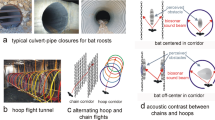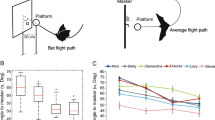Abstract
THE recent discussion of bats in Nature1,2 raises certain questions which I believe can be answered on the basis of new data resulting from a continuation of the investigations in which Dr. Robert Galambos and I were engaged before the War3,4. The bat's ability to avoid obstacles depends upon a method of perception which I have called 'echo-location', or the location of objects by means of echoes5. The bats which we studied emit for this purpose short pulses of sound and hear the echoes which return from any solid object in their path. The emitted sound has a frequency of approximately 50 kilocycles per second, and hence is virtually inaudible to human ears. Many blind men also seem to use some form of echo-location based on audible sounds, for they can often detect obstacles at a distance, but lose this ability if their ears are stopped, or if they are distracted by loud noises6. Radar and the various underwater acoustic devices which locate distant objects by means of echoes are also examples of the general process of echo -location.
This is a preview of subscription content, access via your institution
Access options
Subscribe to this journal
Receive 51 print issues and online access
$199.00 per year
only $3.90 per issue
Buy this article
- Purchase on Springer Link
- Instant access to full article PDF
Prices may be subject to local taxes which are calculated during checkout
Similar content being viewed by others
References
Hartridge, H., Nature, 156, 490 (1945).
Ewer, D. W., Hartridge, H., and others, Nature, 156, 692 (1945).
Griffin, D. R., and Galambos, R., J. Exp. Zool., 86 (3), 481 (1941).
Galambos, R., and Griffin, D. R., J. Exp. Zool., 89 (3), 475 (1942).
Griffin, D. R., Science, 100, 589 (1944).
Supa, M., Cotzin, M., and Dallenbach, K. M., Amer. J. Psyche., 57, 133 (1944).
Noyes, A., and Pierce, G. W., J. Acoust. Soc. Amer., 9, 205 (1938).
Dijkgraaf, S. Verslagen Ned. Akad. v. Wetensch., Afd. Natuurkunde, 52 (9), 3 (1943).
Stevens, S. S., and Davis, H., "Hearing", pp. 184–200 (John Wiley and Sons, New York, 1938).
Author information
Authors and Affiliations
Rights and permissions
About this article
Cite this article
GRIFFIN, D. SUPERSONIC CRIES OF BATS. Nature 158, 46–48 (1946). https://doi.org/10.1038/158046a0
Issue Date:
DOI: https://doi.org/10.1038/158046a0
This article is cited by
-
Early milestones in the understanding of echolocation in bats
Journal of Comparative Physiology A (2018)
-
Vibrogram of the head obtained by the application of mechanical sinusoid oscillations of continuously changing frequency
Acta Neurochirurgica (1950)
-
Supersonic Cries of Bats
Nature (1946)
-
Die Sinneswelt der Fledermäuse
Experientia (1946)
Comments
By submitting a comment you agree to abide by our Terms and Community Guidelines. If you find something abusive or that does not comply with our terms or guidelines please flag it as inappropriate.



